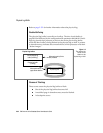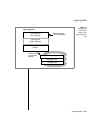
System Architecture 2-71
OnLine Checkpoints
One reason an administrator might want to initiate a checkpoint would be to
force a new checkpoint record in the logical log. Forcing a checkpoint would
be a step in freeing a logical log file with status U-L. (Refer to page 3-41.)
Fast Recovery
A checkpoint is critical to the operation of the fast-recovery process. (Refer to
page 4-39.) As fast recovery begins, OnLine data is brought to physical
consistency as of the last checkpoint by restoring the contents of the physical
log.
During fast recovery, OnLine reprocesses the transactions contained in the
logical logs, beginning at the point of the last checkpoint record and
continuing through all the records contained in the subsequent logical log(s).
After fast recovery completes, the OnLine data is consistent up through the
last completed transaction. That is, all committed transactions recorded in
the logical logs on disk are retained; all incomplete transactions (transactions
with no
COMMIT WORK entry in the logical logs on disk) are rolled back.
Archive Checkpoints
Checkpoints that occur during an online archive may require slightly more
time to complete. The reason is that the archiving procedure forces pages to
remain in the physical log until the tbtape process (that performs the archive)
has had a chance to write the “before-image” pages to the archive tape. This
must be done to ensure that the archive has all timestamped pages needed to
complete the archive. (Refer to page 4-30 for more information about what
happens during online archiving.)


















